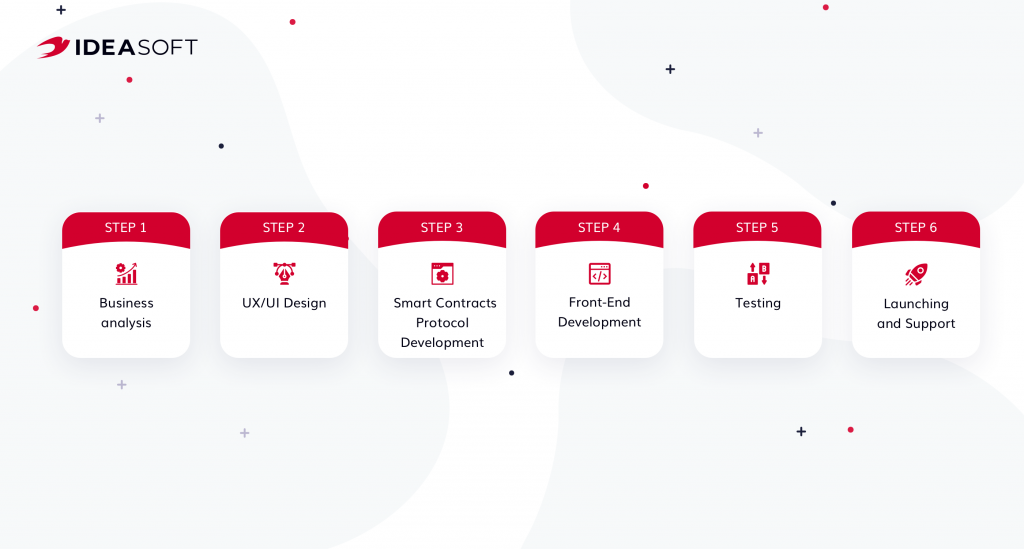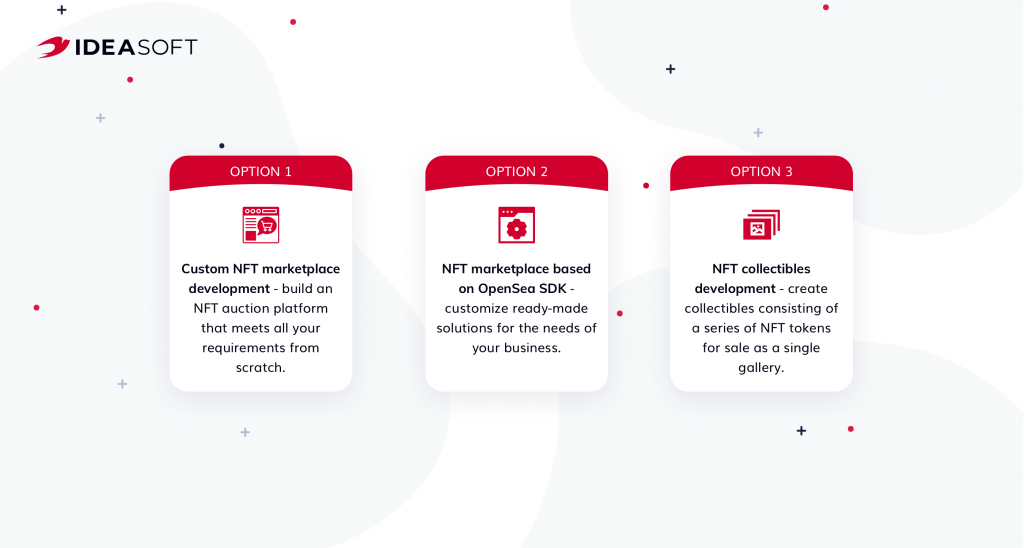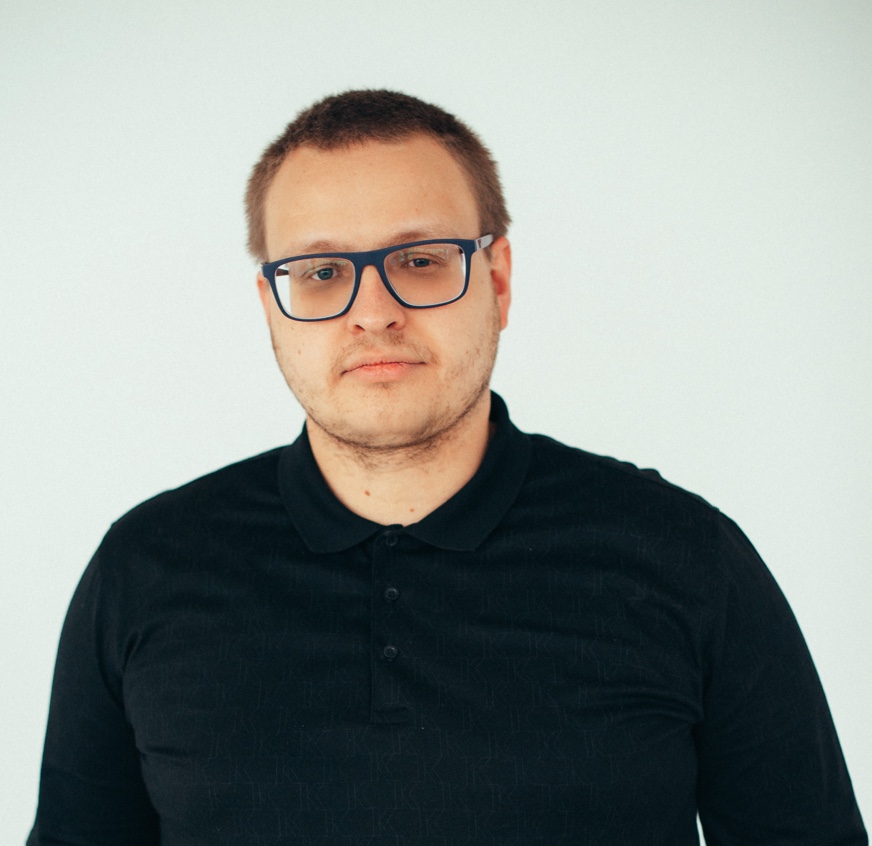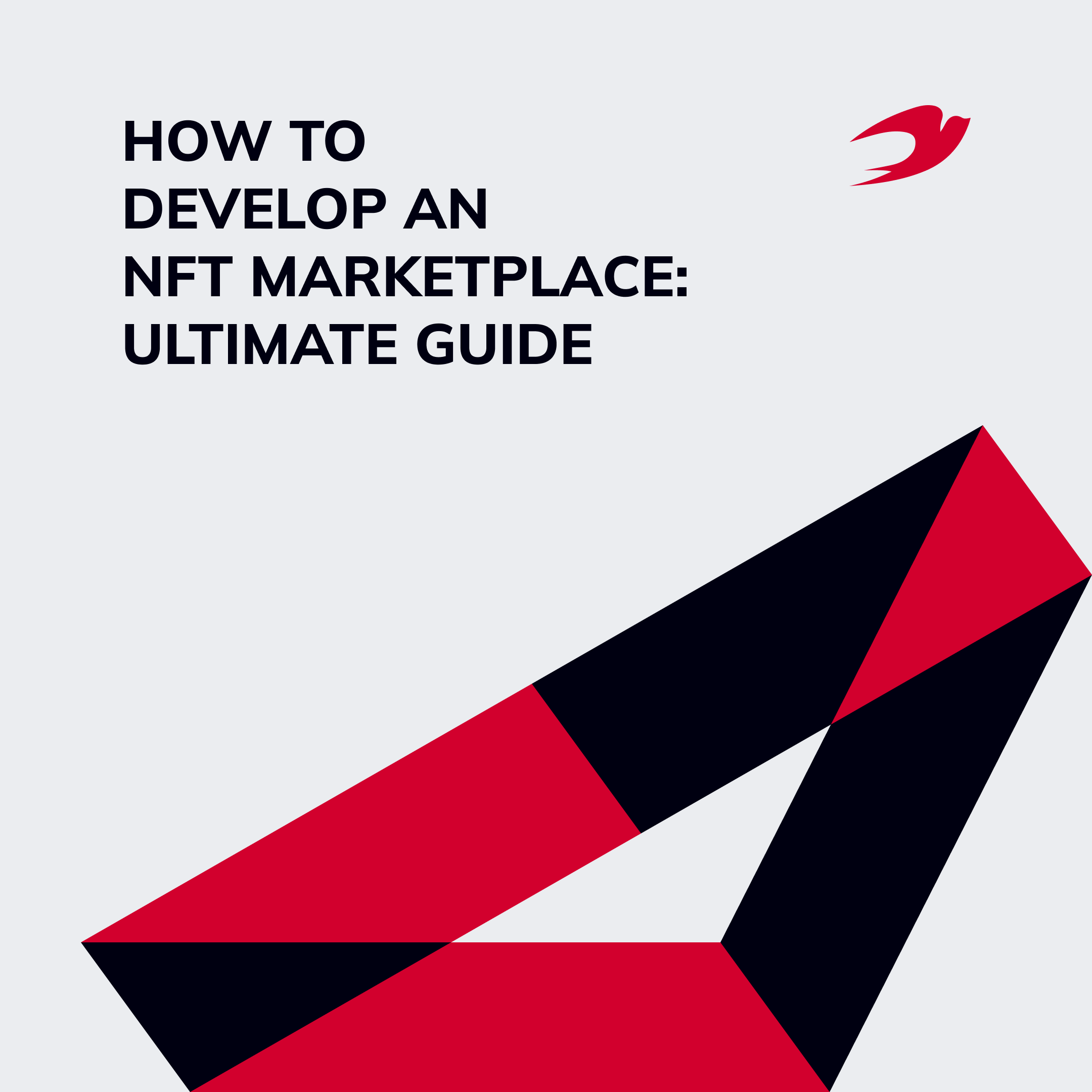I would like to start with some impressive numbers. According to research published on NonFungible.com, the total value of NFT transactions in 2020 increased by 299% compared to the same period last year and exceeded $250 million. Also, the total number of active wallets performing NFT transactions increased by 97%.
Experts predict that non-fungible tokens (NFTs) will become the driving force behind the virtual economy in the next decade. The point is that the NFT market is expected to grow, and it’s time to think about how you can benefit from it. Creating an NFT marketplace is one of the great opportunities for this. So, I have put together a detailed guide that will answer the questions of how to develop an NFT marketplace and succeed. Get ready and let’s get started!
Table of contents:
- Once again, what are NFTs?
- What is an NFT marketplace?
- How does an NFT marketplace work?
- NFT marketplace development: where to start
3.1 NFT marketplace features
3.2 NFT marketplace development with OpenSea SDK
3.3 Custom NFT marketplace development - What to look for when building an NFT marketplace?
- How IdeaSoft can help you build an NFT marketplace
Once again, what are NFTs?
When we talk about NFTs we mean non-fungible tokens. Most NFTs are built on Ethereum using ERC-721 and ERC-1155 standards. Unlike regular tokens, which are fungible and have the same value, each NFT is unique and cannot be replicated, replaced, or split into parts. For example, if you lend someone $10, it doesn’t matter if you get the same bill back. You just need $10, right? But when it comes to collectible coins, each of which is unique and has its own value, the situation changes dramatically. NFT is this unique coin, one of a kind.
NFTs have some properties that differentiate them from other tokens:
- Uniqueness. Each NFT token is a unique asset and it has a unique set of metadata.
- Indivisibility. NFT cannot be divided into smaller denominations.
- Authenticity. Each NFT has an owner and this information is easily verifiable.
- Non-interoperability. One NFT is not equal to another NFT, you cannot simply exchange them, unlike Bitcoin or Ether, for example.
These properties make non-fungible tokens ideal for representing rights to digital assets, which are also unique. Such an asset can be an image, music, any digital artwork, game item, or game character, and so on. Thus, many creators, musicians, collectors have got a chance to become part of the online economy by tokenizing their assets. But still, they need marketplaces for selling/buying NFTs. NFT marketplaces could operate as an auction platform allowing creators and buyers to find and select the best deals for both.
Read the Introduction to Non-Fungible Tokens (NFTs) to find out more about what NFTs are and how they can be used.
What is an NFT marketplace?
Unlike Bitcoin or Ether, you cannot directly exchange non-fungible tokens on various crypto exchanges. To buy and sell NFTs, you need dedicated platforms. NFT marketplace is a decentralized platform that allows you to store and trade non-fungible tokens. Lots on such a platform can be offered at a fixed price or sold through an auction. Most NFT platforms require buyers and sellers to have crypto wallets for carrying out transactions. There are different types of NFT marketplaces. Some are more exclusive, while others are focused on letting anyone create and sell their art.

There are universal platforms where you can find anything from art to domain names, such as OpenSea, Rarible, Mintable. On these marketplaces, you can turn any creations into items and start selling them. Other platforms are niche. They focus on selling certain assets. For example, Valuables allows you to sell and buy tweets (you’ve probably heard that Twitter CEO Jack Dorsey auctioned off his first tweet as an NFT); Looking Glass Factory offers a marketplace for selling digital holograms, and so on. Niche marketplaces are gaining popularity because they have a more clearly defined target audience and solve specific problems. Also, you can find closed marketplaces available only for approved creators, such as Foundation.app. So, you should definitely think about platform type before developing an NFT marketplace.
How does an NFT marketplace work?
NFTs are implemented using smart contracts. Each token contains a set of unique information (metadata) recorded in its smart contract, and a blockchain provides its immutability and security. To build an NFT marketplace, we need to create a token protocol, usually on the Ethereum network. This is a special group of smart contracts that ensures the implementation of certain functionality of marketplace features. Further, this protocol is integrated with the marketplace system.
Now let’s talk about how NFT marketplaces work from the client-side. For the most part, all NFT auction platforms share a common flow. First of all, a user needs to sign up for a platform and install a digital wallet to store NFTs and cryptos. The registration process on the platform is directly related to a crypto wallet, basically, you sign up with your wallet. Then the user can create his collection by loading items to display his work. The user can also choose which payment tokens he’d like to accept for his art and set a secondary sales fee if the platform suggests it.

The next step is listing items for sale. The user can select a bid for an auction or a fixed price. When listing an item for sale, a transaction is created that launches a personal trading smart contract for the user wallet. The platform may require collection moderation, and after approval, your NFTs will appear on the list for sales and you can accept bids. Usually NFT marketplaces charge some fee on the purchase amount. Also, NFT platforms handle the transfer of items and funds, so for users, the whole process looks pretty simple.
NFT marketplace development: where to start
Now that you know how NFT marketplaces work and what types of these platforms are on the market, it’s time to discuss your project in more detail. If you wonder how to develop an NFT marketplace, I would suggest you start with the business part. As with any other software product, you need to know well who you are building your platform for and what problems it will solve. You have to decide on a list of features and choose one of several options of technical implementation of your idea.
NFT marketplace features
NFT marketplace combines marketplace and auction platform features. Users should be able to create their own collectibles and sell them. Also, different marketplaces offer some additional functionality to attract users and make their user experience exceptional. Start your list with core platform features that will allow users to carry out basic operations:
Storefront
The NFT auction platform is a marketplace, so it should have a storefront. Provide users with all the necessary information about an item: preview, bids, owners, price history, etc. OpenSea, for example, also displays chain info for checking the smart contract so a buyer can be sure of the authenticity of the purchased NFT.
Searching for items
As with any marketplace, your platform should support category management and tagging to make it easier for users to find collectibles they are interested in. Implement a search bar on the site, add categories. For example, OpenSea divides items into the following categories: Art, Domain Names, Virtual Worlds, Trading Cards, Collectibles, Sports, Utility. You can choose yours.
Filters
Filters also make it easier to navigate a site, especially if there are a lot of collectibles on the platform. Give users the possibility to select items by category, payment method, collection, listing status (e.g. “new”, “has offers”, and so on). This will significantly reduce the time between NFT selection and purchase.

Creating listings
The process of NFTs submission and creation of the collection should not take long. Think about the flow and most likely you need something like OpenSea’s Collecting Manager to easily manage collections and items. On the collectible creation page, a user should be able to upload a file and fill in the basic token properties such as name, description, tags. I advise you to sign up for several marketplaces to find out what flow of creating NFT and listing it for sale you like the most, what stages you would do better.
Status of listing
Status of listing also assists users in selecting NFTs for purchasing. By searching, sorting, and filtering, they can find the best options faster and easier. Also, statuses help sellers navigate better as well, especially if you want to implement a collectible verification process. This way you can inform sellers at what stage of the verification process their items are.
Buying and Auction
The development of the auction mechanism for your platform is one of the most critical parts of the project. You need to provide bidders with an easy-to-use and efficient NFT buying system. It is better to include the bid expiration date in the form to give users more control over their bids. Plus, the auction watchlist allows viewing details about the current status of bids.
Wallet
Your users need wallets to send, receive and store cryptocurrencies and non-fungible tokens. The easiest way to do this is to provide a user with a connected wallet that he already uses. For example, Rarible offers platform members to connect one of the wallets of their choice: MyEtherWallet, Coinbase Wallet, Formatic, or WalletConnect. OpenSea offers several additional options. So, we also need to compile a list of wallets that must be supported by the platform and ensure their integration.
Ratings
Ratings are a great way to help new users choose NFTs. Plus, they act as a reward for the best top sellers, confirming their reliability. So you can use this as an additional feature.
In fact, NFT marketplace features are not limited to those listed. Each platform offers some kind of unique functionality. This way they try to improve communication with users and increase the level of user engagement. Rely on your ideas. For example, you can implement a push notification system to inform users about bid changes, new collectibles, or the status of their listings. Or develop a community by creating a forum on the platform. Some marketplaces also have their own blogs. Draw the perfect NFT marketplace in your mind and it will become the starting point of your project.
Read also ‘How to start a successful DeFi project’
NFT marketplace development with OpenSea SDK
Once you have a list of features for your future platform, we can talk about the technical implementation of the project. This is a more engineering answer to the question of how to develop an NFT marketplace. You can find some ready-made tools for building non-fungible token marketplaces. For example, OpenSea offers an SDK that allows you to create such a platform using OpenSea’s infrastructure, but with your design on the top.
OpenSea’s SDK opens up enough opportunities for building a functional NFT marketplace, including the ability to sell items for your own ERC 20, make a profit, enable private listings, bulk transfers, and more. The SDK allows you to create ERC-721 or ERC-1155 (semi-fungible) items. Also, the good news is that you don’t need to deploy your own smart contracts. This toolkit greatly simplifies the NFT marketplace development process with ready-made blocks. However, If you don’t have a technical background, it will be quite difficult for you to do it yourself. Therefore, I advise you to contact blockchain specialists who know how to develop an NFT marketplace using the OpenSea SDK.
Custom NFT marketplace development
In some cases, off-the-shelf toolkits may not meet all project requirements. This is when the custom NFT marketplace development comes into play. With the support of an experienced development team, you can create a non-fungible tokens marketplace with any functionality from scratch. While this option will cost you more, it has many advantages. As a minimum, you are not limited by the SDK’s capabilities. You can implement any features you have in mind and build a more complex solution that will help you stand out from competitors and attract more users.

The custom development process for the NFT marketplace consists of the following steps:
- Business analysis. At this stage, you need to describe the business part of your project: for whom your product is being created, which features you need to implement, which user flow to build. The more accurately you study user behavior, the more user-friendly solution you can create. Nobody likes complexity. Therefore, our task is to build a simple and effective marketplace architecture. I advise you to include business analysts at this stage so as not to miss a thing.
- UX/UI design. When developing a marketplace, the UX/UI part is crucial. The user interface should be clear and simple. Good UX/UI is the golden mean between usability and a nice look and feel of your platform. I highly recommend consulting a professional when creating the UX/UI for your product. If users experience issues interacting with your marketplace, you gave the money away, and no talented developers can fix that.
- Smart contract protocol development. Back-end is the logic of your platform. When designing an NFT marketplace, this step will be different from a similar step in standard custom development. The thing is NFT marketplace is a decentralized platform, so most of the data is verified on a blockchain. For instance, Ethereum allows the network to run certain scripts to make an app decentralized, so most of the backend logic is transferred to the decentralized part.
- Front-end development. This is the stage for bringing your design to life. Choosing the best framework for your project, software developers implement all the necessary features on the client-side. The main task here is to ensure fast operation of the platform, good performance, and reliability.
- Testing. You should never skip this step. Detecting and fixing bugs promptly makes you sure that your product is ready to launch. Plus, software testing allows you to make sure that your platform works as intended and meets the original project requirements. Remember that a properly tested software product provides reliability, security, and high performance.
- Launching and support. Once you are sure that your platform is bug-free, it’s time to launch your NFT marketplace. Many people think that this is the last step, but software is software, you need to constantly work to maintain and update it. Plus, speaking from personal experience, I can tell you that 80% of clients usually come back to us for implementing new features, because the business needs to meet the growing expectations of users. So, don’t lose contact with your development team, which will become your reliable partner for years.
Check with blockchain developers to find out if you need custom development or you can use the SDK. To do this, be prepared to provide a team with a list of platform features.
What to look for when building an NFT marketplace
There are two main things you should pay special attention to when building an NFT marketplace. They are essential to your success. Among these things are security, and the choice of an experienced development team. Let’s dwell on each point.
Security
You cannot ignore security when it comes to finances. Blockchain is a fairly reliable technology that has built-in security mechanisms, but additional features never hurt. You may need tools to inspect and detect malicious content that could harm your users. You can also implement additional checkboxes in the process of publishing or buying tokens so that users can be sure of their authenticity and reliability. A user profile is also an important security element. Implement at least basic KYC (know your customer). For example, OpenSea invites users to add links to their social media accounts to help NFT buyers find out more information about creators.
Experienced blockchain development team
So we got to the choice of the development team. I don’t want to waste a lot of time explaining how important it is to work with experienced blockchain developers to get a quality software product. It’s obvious. I’d rather try to give you some advice when choosing the right software provider.
First, outsourcing development teams will help you significantly speed up the process of creating your NFT marketplace. Especially when it comes to companies that provide full-cycle development services. This is the most cost-effective solution.
Second, check the expertise of the company you intend to work with. How to do it? Check the delivered projects, make sure the team has experienced blockchain developers, find feedback on the company’s work. Make sure a software provider can cover all your project-related requests.
Finally, just find out if you enjoy communicating with the team. If communication is easy and casual, and the team understands your goals, your project is more likely to be successful.

How IdeaSoft can help you build an NFT marketplace
After you’ve learned how to develop an NFT marketplace, it’s time to talk about how our team can help you. IdeaSoft is a custom software development company providing full-cycle software development services, from business analysis and UX/UI design to deployment, testing, and support. Since 2021, IdeaSoft has been part of Sigma Software Group, Swedish software development and IT consulting company with over 1,150 specialists in Ukraine. Blockchain development is one of the main specializations of IdeaSoft.
The five-year history of the company includes successful projects of crypto exchange platforms, blockchain protocols, trading platforms, issuance platforms, and more. Our client list includes Biteeu, a fully licensed and compliant cryptocurrency exchange for the European Union; Bochica, the first Colombian blockchain; Securutize, an issuance platform that entered the list of Blockchain 50 Most Promising Companies within the Blockchain Ecosystem by CB Insights in 2020. Feel free to check out our portfolio to find out more about these projects.
If you want to build your own NFT marketplace, we can offer you several options, including custom development and creating a marketplace based on the OpenSea SDK. We are not limited to the types of digital assets, so we can develop an NFT platform that meets all your requirements. IdeaSoft team can also develop separate NFT collectibles, like Hashmasks, if you need to sell a series of tokens. For this, the distribution of tokens is created once, they are divided by rareness and sold as one large gallery. The value of assets depends on the rarity of tokens.

Check the Blockchain development page to learn more about IdeaSoft services or contact us here to discuss your project. I can’t wait to hear your ideas!

